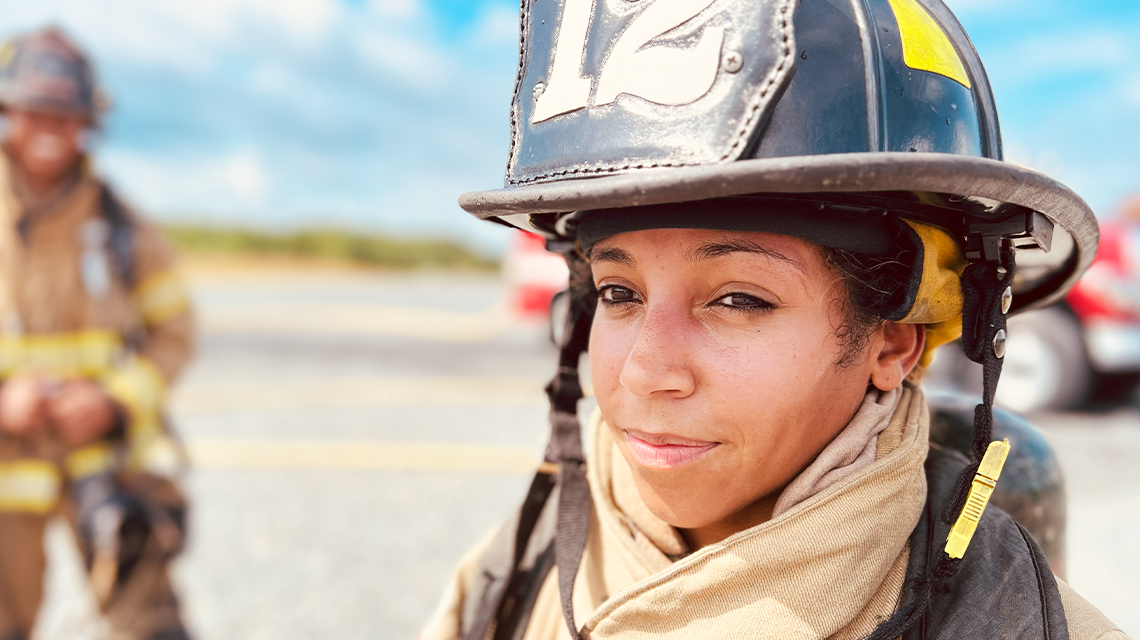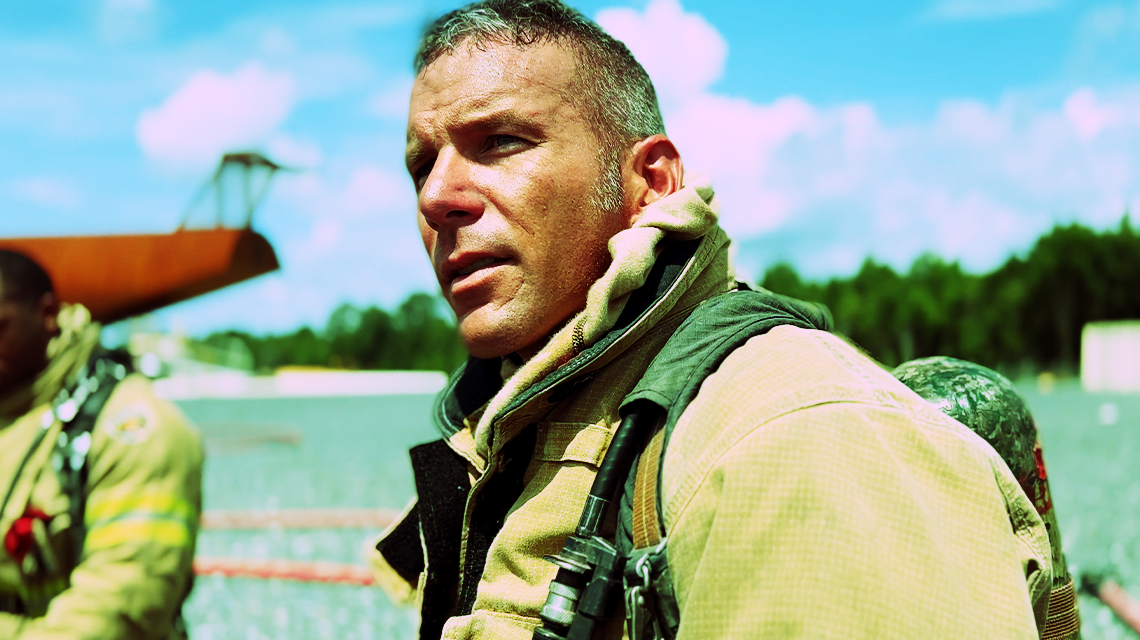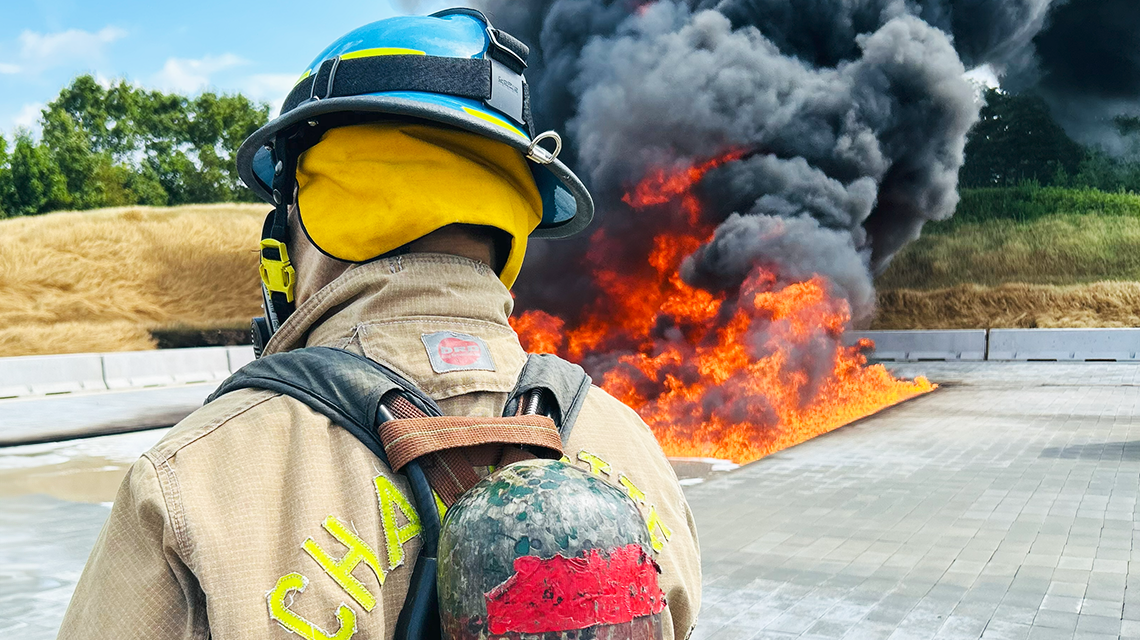Training for the Skies: Charlotte Fire Protects a Global Aviation Hub
Published on July 18, 2025

Flames and heavy black smoke rise as Charlotte Fire personnel prepare to deploy foam during a federally required Aircraft Rescue and Firefighting (ARFF) evolution.
At Charlotte Douglas International Airport, where a record-setting 58.8 million passengers moved through terminals in 2024, the firehouses protecting the runways stand ready for the unimaginable. Firefighters assigned to Charlotte Fire’s airport division at Firehouse 17 and Firehouse 41 are specially trained to respond to high-risk aviation emergencies that demand skill, speed, and absolute precision.
Before they ever respond to an alarm at Charlotte’s airfield, newly promoted Firefighter II personnel undergo some of the most rigorous training in the department. It is not only required by federal regulations, it is essential to be fully prepared for the unique challenges of aircraft rescue and firefighting, known as ARFF.

Firefighter Jasmine Kingcannon stands on the airfield during training, part of a team learning to manage jet fuel hazards and tight aircraft interiors with speed and precision.
This month, Charlotte Fire’s newest Firefighter IIs completed a critical phase of their ARFF training at the Emergency Training Center in Stanly County, a facility operated by the North Carolina Office of the State Fire Marshal (OSFM) in partnership with the North Carolina Air National Guard Fire Department and Stanly County. The state-of-the-art center features a full-sized E-Index aircraft prop and open burn pit, allowing firefighters to meet FAA certification requirements and train for realistic aircraft fire scenarios.
The facility is undergoing a major expansion, scheduled for completion in 2025, that will make it one of the most advanced emergency training centers in the country. Once completed, it will support additional training in specialized disciplines including Aircraft Firefighting, Swift Water Rescue, Urban Search and Rescue, and Hazardous Materials response.
For Charlotte Fire, access to such a facility ensures that airport-assigned personnel are equipped with the skills and experience needed to operate confidently in one of the most high-risk emergency environments.

An aerial view of the Emergency Training Center shows the scale of the facility used to prepare Charlotte Fire personnel for the unique challenges of airport firefighting.
Leading the training was Captain Evan Moore, ARFF Training Officer for Charlotte Fire. Moore has helped shape the evolution of Charlotte’s airport-based training program and understands the complexity of responding to emergencies at one of the world’s busiest airports.
“The fuel load alone changes everything,” Moore said. “Jet aircraft can carry 30,000 to 40,000 gallons of fuel. Add to that the potential for mass casualties and it creates an environment that is both physically and mentally demanding. Our firefighters have to be prepared for that.”
Charlotte Douglas ranks as the seventh busiest airport in the world for aircraft arrivals and departures, according to Airports Council International. In 2024, the airport saw nearly 600,000 aircraft movements. With that volume of activity, fire crews at the airport must be ready around the clock.
The E-Index jet prop allows Charlotte’s airport firefighters to simulate the rescue and suppression operations they might face in a real emergency. That includes navigating narrow aisles, manipulating hose lines between rows of seats, and working in zero visibility conditions.

Captain Evan Moore, ARFF Training Officer, has served at Charlotte Douglas since 2017 and oversees specialized training for airport-assigned Charlotte Fire crews.
“It is nothing like operating inside a house fire,” Moore said. “In an aircraft, everything is tighter. There are three rows of seats, overhead compartments, and multiple aisles. Firefighters have to move differently and think differently.”
One of the most significant evolutions in this year’s training involved the use of fluorine-free foam. For the first time, Charlotte Fire crews were able to train using F3 foam, an environmentally safe product that has replaced traditional firefighting foams previously restricted due to environmental and health concerns.
“For years we could not train with foam at all because the old foam contained harmful chemicals,” Moore said. “Now that we are using F3, we can show our personnel exactly how it behaves on fuel fires. They get to see it in real time. That experience is a game changer.”
Unlike water, which can cause burning fuel to spread, firefighting foam creates a vapor-suppressing blanket that cools the fuel and extinguishes the fire. It is essential to effective suppression during jet fuel fires.
“When they light off the jet fuel pit, it is a huge amount of fire,” Moore said. “And within a minute or two, that foam can knock it down completely. Seeing that for the first time leaves a lasting impression.”

Charlotte Fire Training Officer monitors the progression of a controlled fuel fire, part of realistic ARFF training scenarios conducted in a full-scale outdoor burn pit.
But the training goes far beyond fire behavior. The firefighters assigned to Charlotte’s airport firehouses must also become experts in navigating secure airfields, understanding aircraft design, coordinating with air traffic control, and maintaining situational awareness in a constantly evolving environment.
“There are no hydrants on the airfield. Every truck has to be escorted. Every response requires coordination with the tower,” Moore said. “Even during emergencies, the airport still has to operate. That means our actions have to be efficient, effective, and fast.”
Charlotte Fire Chief Reginald Johnson emphasized the critical nature of the department’s presence at the airport.
“Charlotte Fire’s responsibility at Charlotte Douglas is one of the most complex and high-risk assignments in our department,” Johnson said. “The level of training, the commitment to readiness, and the professionalism our airport personnel demonstrate every day is a reflection of the standard we uphold across the entire organization.”

Firefighter Hunter LeBlanc takes a moment during hands-on ARFF drills designed to sharpen readiness and reinforce coordination on the airfield.
Firehouse 17 and Firehouse 41 each play distinct roles in supporting operations across the airfield and within the terminal. Emergency medical calls, fuel spills, aircraft mechanical issues, and full-scale drills are all part of a weekly rhythm. Many of the engine company calls happen inside the terminal, where after-hours emergencies are especially common.
Moore explained that understanding the layout of the airport is just as important as knowing how to fight fires.
“Charlotte Douglas is always changing,” Moore said. “Construction is happening constantly. Stores move overnight. You can walk the terminal twice a week and it will look completely different. That level of change means our firefighters need to stay alert and flexible at all times.”
For the Firefighter II personnel completing the ARFF training this month, the lessons extend beyond tactics and tools. The experience serves as a reminder that the airport is not a slower or easier assignment. It is a place that demands constant preparation, situational awareness, and a deep sense of responsibility.

Charlotte Firefighters climb aboard a full-sized aircraft prop to simulate interior suppression and rescue operations, an essential part of FAA-mandated ARFF certification.
“Some people think being at the airport means fewer fires or slower days,” Moore said. “But it’s actually the opposite. The calls are different. The hazards are more complex. And when something goes wrong out here, it goes wrong in a big way.”
Training days like the one in Stanly County are just the beginning. It typically takes up to a year before a new firefighter at the airport feels fully proficient with the procedures, access requirements, and operational expectations.
“They have to learn to drive on the airfield, pass FAA requirements, and get their airport credentials. That’s all before they even step foot inside an aircraft prop,” Moore said.
For Moore, the training is more than a checklist. It is about instilling confidence, building capability, and fostering teamwork under pressure.
“I want them to walk away with a better understanding of foam operations, sure,” he said. “But I also want them to walk away with a sense of just how serious this work is. Every second counts when something happens out here. Being ready is not optional.”

Seen from above, Charlotte Firefighters apply foam to suppress a large-scale simulated fuel spill fire at the Emergency Training Center’s burn pad.
Charlotte Fire’s commitment to excellence at the airport matches its commitment throughout the city. But at CLT, where the sky is busy and the ground is unforgiving, the firefighters of 17 and 41 serve with a quiet confidence that only comes from relentless preparation.
When millions of passengers take off or land at Charlotte Douglas, few may think about the fire crews standing by just beyond the runway lights. But they are there, trained to the highest standards, ready to respond to emergencies that may never come, but that they prepare for every single day.
For the newest Firefighter IIs now assigned to the airport, that training is not just about protecting lives. It is about carrying forward a legacy of excellence at one of the world’s busiest airports and being ready to meet the moment when it matters most.

Charlotte Fire’s newly promoted Firefighter IIs observe the ignition of a jet fuel pit during live-burn training at the Emergency Training Center in Stanly County.
FIREFIGHTER APPLICATION